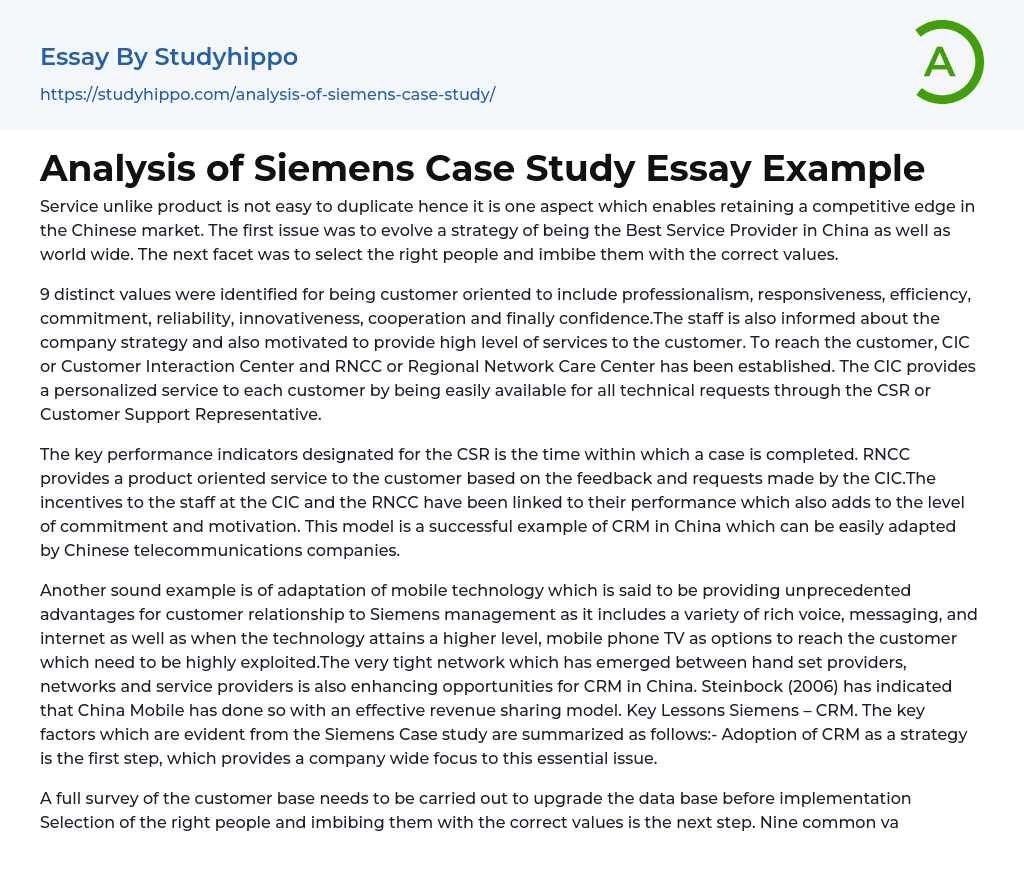Unlike products, services cannot be easily replicated. This is why having a strong service offering is crucial for maintaining a competitive advantage in the Chinese market and beyond. Our first priority was to develop a strategy for becoming the top service provider both in China and globally. The next step was selecting the right individuals and instilling in them the appropriate values.
A total of 9 different qualities were discovered as essential for being customer-oriented, including professionalism, responsiveness, efficiency, commitment, reliability, innovation, cooperation, and confidence. Additionally, the company's staff is well-informed about the overall strategy and highly encouraged to deliver top-level service to customers. To improve customer communications, both a Customer Interaction Center (CIC) and Regional Network Care Center (RNCC) have been implemented. The CIC ensures a customized and accessible experience for any technical inquiri
...es through their Customer Support Representatives (CSRs).
The time taken to complete a case is the targeted key performance indicator for the CSR. The CIC provides a product-focused service to customers that revolves around feedback and requests. Employee incentives are tied to performance, promoting commitment and motivation. This example of CRM in China has proven successful and can be readily adopted by the telecommunications industry in China.
Siemens management has seen unprecedented advantages in customer relationship through the adaptation of mobile technology. This includes a variety of rich voice, messaging, and internet options as well as the potential for mobile phone TV, which needs to be fully utilized. The tight network between hand set providers, networks, and service providers in China is also enhancing opportunities for CRM. Steinbock (2006) highlights the effective revenue sharing model implemented by China Mobile. The key factor
evident from the Siemens case study include adopting CRM as a strategy to provide a company-wide focus on this essential issue.
A survey of the customer base must be conducted to update the database before implementing CRM. The next step is choosing and instilling individuals with correct values. Siemens has identified nine common values, including professionalism, responsiveness, efficiency, commitment, reliability, innovativeness, cooperation, and confidence. It is crucial to establish an organization for CRM implementation, such as the CIC or Customer Interaction Center and RNCC or Regional Network Care Center for addressing customer needs. Staff performance appraisal and incentives should be based on customer satisfaction. To provide effective inputs for the database, a BUDI (Buyer, User, Decider, Influencer) model can be used to assess customers.
One focus is on creating standards to measure customer satisfaction levels and connecting employee training, motivation, and performance with CRM. It is suggested that employee performance metrics should be based on CRM data. The study delves into the Chinese telecommunications sector's use of CRM practices and outlines the industry's growth from 13.77 million in 1997 to 150 million. A literature review and case study analysis provide a thorough understanding of the current state of CRM in this sector.
Displayed in the graph below is the increase in telephony usage in China, rising from 360 million in 2001 to 441 million in 2004 (blue), as well as the percentage growth (red). However, it has been observed that despite high telephony penetration rates, customer satisfaction with service quality may be inadequate. The primary reason for over 40% of Chinese telephony users switching providers may be due to pricing issues. As revenue inflows have not kept pace
with customer growth, Chinese telephony companies must vie for customers. Companies like Hunan Telecom have recognized this need and established call centers to implement basic and reactive levels of customer relationship management (CRM).
According to the graph below, other factors that have an impact on competition and customer relationship management (CRM) are the implementation of 3G technology, increased regulation, foreign investment, and gradual adoption of WTO standards.
- Advertising essays
- Audience Theory essays
- Competitor Analysis essays
- Consumer essays
- Marketing Management essays
- Marketing Mix essays
- Marketing Plan essays
- Marketing Research essays
- Marketing Strategy essays
- Point Of Sale essays
- Price essays
- Procurement essays
- Product essays
- Product Differentiation essays
- Promotion essays
- Promotion And Marketing Communications essays
- Retailing essays
- Trademark essays
- Anheuser-busch essays
- Brands essays
- Detergent essays
- Product Placement essays
- Research Design essays
- New Product Development essays
- Advertisement essays
- Brand essays
- Sales Promotion essays
- Advertising campaign essays
- Consumer behaviour essays
- Offer And Acceptance essays
- Wal-Mart essays
- Discover essays
- Customer essays
- Customer Satisfaction essays
- Customer Service essays
- Target Market essays
- Accounting essays
- Andrew Carnegie essays
- Automation essays
- Business Cycle essays
- Business Intelligence essays
- Business Model essays
- Business Operations essays
- Business Software essays
- Cooperation essays
- Cooperative essays
- Corporate Social Responsibility essays
- Corporation essays
- Customer Relationship Management essays
- Family Business essays




